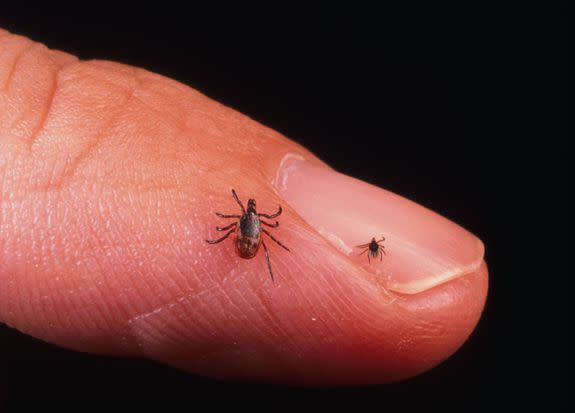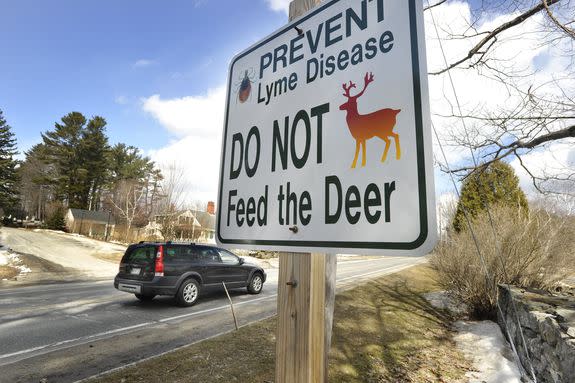Illnesses from ticks and insects have tripled in the US since 2004. Here's why.
A doctor in Denver, Colorado recently called tick biologist Nathan Nieto to say that he found a lone star tick feeding on a patient.
The problem is, lone star ticks aren't supposed to be found anywhere near Denver. These ticks are supposed to live in the eastern United States, said Nieto, a biologist at Northern Arizona University, in an interview.
But ticks, along with mosquitos and other biting insects, are now spreading disease throughout the United States. The Centers for Disease Control and Prevention (CDC) released a report Tuesday showing that diseases from biting insects, ticks, and mosquitos in the U.S. have tripled since 2004.
SEE ALSO: How did what could be the largest human organ elude us until 2018?
As advances in gene-therapy, alternative antibiotic treatments, and many aspects of public health progress in the United States, it appears we have little sway (without blanketing the land with toxic chemicals) over the innumerable disease-carrying insects that inhabit our neighborhoods, homes, and backyards.
Although the CDC points out that many illnesses from insects still go unreported, the agency report found that between 2004 and 2016 over 640,000 cases of disease — notably Lyme disease from ticks and viruses from mosquitos — were documented in the U.S.
There's no sign of the insect-borne onslaught abating.

"Mosquitos and ticks and infections are moving into new areas nationwide," CDC Director Robert Redfield said in a call with reporters.
"There appears to be an accelerating trend," added Lyle Petersen, the director of the CDC's Division of Vector-Borne Diseases.
Although the CDC isn't able to document all such cases in the U.S. (Peterson said the number of Lyme disease cases that occur each year are ten times higher than are actually reported), he said the trend is nearly unquestionable.
"From a rainstorm, you don’t have to count every different drop to know how much rain there is," he said.
Video: How to Protect Yourself From Ticks and Mosquitos
For more news videos visit Yahoo View.
Warming temperatures are playing an important role
There are a few important factors at play, but a prominent influence is increasing average temperatures in the U.S.
"We know temperature is very important," said Peterson. "If you increase temperature, in general tick populations can move further north and extend their range."

Image: Getty Images
During the call, the CDC's Peterson declined to answer whether or not human-caused global warming was responsible for these temperature increases, as he said that's a task better left "for meteorologists."
Federal science reports have tied increasing average temperatures in the U.S. and worldwide directly to human emissions of greenhouse gases, and one consistent prediction from climate scientists and public health experts has been that vector-borne illnesses, that is, diseases spread by mosquitos, ticks, and other species, would increase over time and move into new areas.
Warming is having a considerable effect on both mosquito and tick populations. Mosquito-borne diseases tend to get worse during heat waves, and increasing temperatures make the bloodsuckers more infectious by allowing them to carry more viruses, such as Zika or West Nile, Peterson said.
Scientists, meanwhile, are watching ticks expand to new frontiers.

"We're seeing populations moving through Ohio and the upper Midwest," said Nieto. "Thirty or 40 years ago they didn’t have a tick problem — but now they do."
Warmer temperatures allow ticks to emerge earlier in the season, Nieto said, allowing for more opportunities to infect hosts, like deer and people.
And once they arrive in new places, our infrastructure — like water around our homes — can sustain these disease-carrying bugs, year round.
"There used to be a quick pulse in the spring and then everything would die off," said Nieto. "Now they’re showing up in new areas, then establishing populations in these places."
Travelers also help spread bugs around the country
"All these diseases are basically a plane flight away," said the CDC's Peterson.
Many bugs arrive likely arrive in the U.S. by plane. The West Nile virus likely arrived by plane in 1999, and Zika in 2015, Peterson said. For insects already here, car and air travel can easily transport pests like ticks around the country.
"We hypothesize that people are moving ticks around like crazy, and they live for days," said Nieto.

Image: ohn Ewing/Portland Press Herald via Getty Images
There is also evidence evidence that birds transport disease-carrying tropical ticks into the country.
The solution for limiting the spread of ticks and insects is simple, though somewhat limited: increasing public awareness about the expanding problem and ensuring local health departments are equipped to track these insects and control them, with effective pesticides, when necessary.
But the CDC acknowledges that it can't do the job alone. State and local health departments need to both educate people about how to protect themselves, and how to try and control the abundance of the disease-harboring bugs in their communities, said the CDC's Redfield.
WATCH: Michael Phelps discusses how he learned to overcome suicidal thoughts


